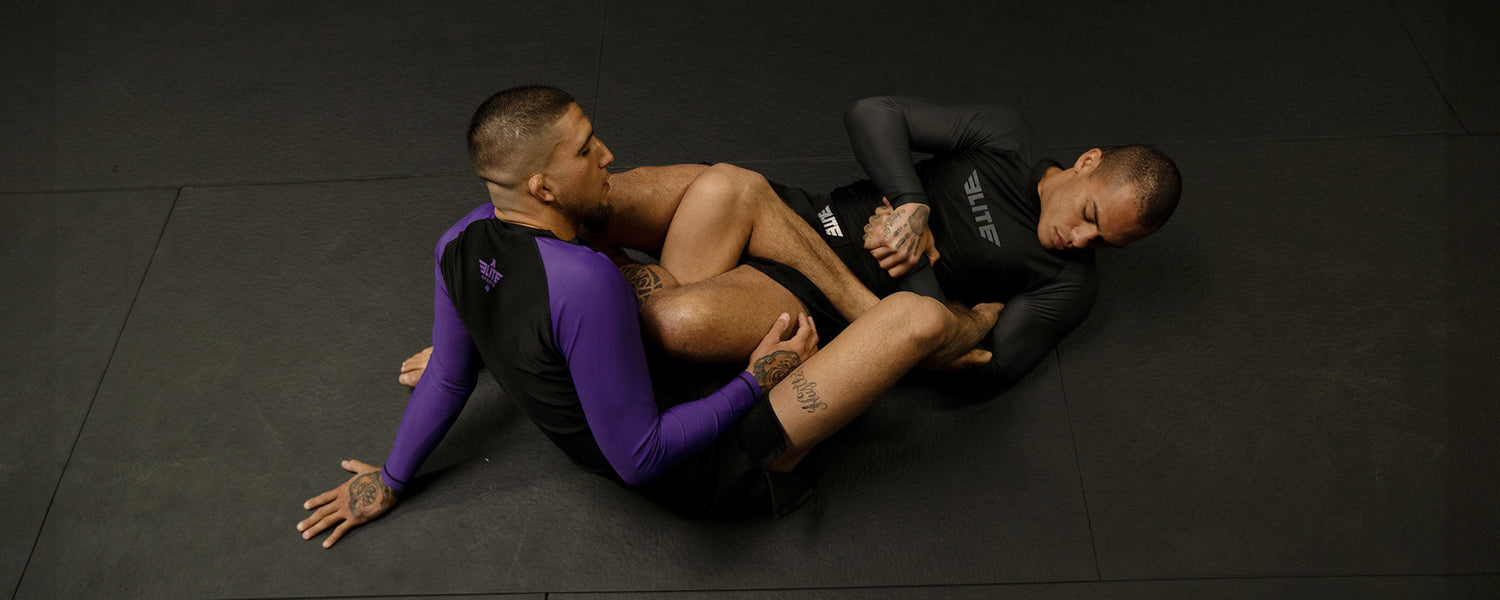You wanted to be the best BJJ competitors, right? Brazilian jiu-jitsu:focus on the grappling and striking that works on leverage, joint locks, chokes not much background in this art. During fights leg locks hooks are used by the contenders.
Initially, they are less versed in fighting with leg locks. This is because their opponents have used them so few times against the fighters that many do not view it as a legitimate weapon. And they are then regarded as some of the best ways to improve your jiu-jitsu. Leg locks have become the most popular weapon in a game by all top athletes.
The fighters take the most time to apply a submission, and that is partially why leg locks are better than your bout when you use them. The ankle locks will increase the effectiveness of the tournaments and provide desirable results.
Table of content
1. What is an Ankle Lock?

An ankle lock is, as its name suggests a joint lock applied to the ankle, also referred and fused with another name which was known as Achilles Lock. It is a traditional submission technique of using leverage with a one hundred percent success rate. There are less likely opportunities for the same fighter to escape out of the submission if you have your opponent locked into an ankle hook.
The joint lock causes intense pain that creates an irresistible pain that cannot be tolerated by the opponent, and he will submit immediately. If so, then keep reading and don't go anywhere as we unveil everything about the ankle lock. You will learn about ankle locks include the history, mechanism,and execution.
2. History of Ankle Lock
Read the article below and you will explore the potential of the ankle locks. this joint lock is a submission that can also be found in other martial arts such as Judo, and Sambo. ankle lock is the leg lock that has been used in many of martial arts for about 200 years.
The ankle lock probably originates from catch-wrestling, which is common in Japanese martial arts, too. Over time, the ankle lock has evolved, and a person can use it in various styles. So, with the passage of time, the preferences of athletes changed, and ankle locks became more prevalent or less over time.
The ankle lock is a slightly challenging move that takes some practice to submit to your opponent if you have an in-depth understanding of the concept. Its effectiveness was became even more popular that it will got the prominence, and became the highly effective leg lock. Today, the most basic leg lock in Brazilian jiu-jitsu is ankle lock.
3. Mechanism of Ankle Lock
Ankle lock appears to be the basic leg-lock, but it is much more complex than a straight ankle. It attributes to the small complexities of the ankle lock as a submission. Ankle lock anatomy is more complex;. has comparatively intricate structure; it is a joint that holds together three major bones:
Tibia
Fibula
Talus
As the fighter attacks with the Achilles tendon, he targets the three primary leg bones that demand particular attention.
Note that if pressure is exerted more than the required limit and if an angle changes the smallest amount, a fighter could experience a structural change like boned snapping. This is the grip used to prevent the joint (an arm in this instance) from moving; it's also one of its most essential components, being that without it, there would be no submission.
The fighter is keeping their hand at torso level by use of the forearm above the wrist. This unaffectedly will oppose movement through the application of force, and the opponent will stay on the mat.
The fighter needs to maintain the proper angle that locks the three main parts of the legs: the hip, knee, and ankle. Pressure is exerted on the foot, which increases the pain, and the opponent tends to submit instantly.
4. How to Apply Ankle Lock

Ankle lock’s central point is to work on the bones of the legs, which creates a significant pain that makes the opponent tap instantly. It works on the mechanism of the proper grips and pressure execution.
If you are looking to execute an ankle lock, before that, you need to gain the proper control over the opponent. Without gaining the dominant position, one can not proceed further. Let us find out how to execute the ankle lock step by step.
4.1. Take the Position
The first step is to take the proper position. If you are in the standing position and your opponent is in the open guard, keep one leg between you and target one of his legs.
4.2. Target the Leg
Bend down slightly by keeping one leg on the mat and the other halfway up or standing. Target one of the opponent’s legs with a firm grip of the hand.
4.3. Lock the Foot
After targeting the leg, hold the shin and slide your hand upward, locking the foot under the armpit. The foot should be over the arm.
4.4. Step Inside
Move your foot inside to create a space so that you can reach the mat. Make sure to have a firm grip over the foot and settle down.
4.5. Placement of the Foot
When the fighter is on the mat, after having a secure grip, he needs to put his leg over the targeted leg. This will restrict the movement of the leg.
4.6. Fall to One Side
It is the most fundamental step that has created maximum effectiveness. Place the other hand over the knee and bend towards the side where you have grabbed the leg. Keep the hand on the mat to secure the position.
4.7. Pressure on Toe Nail
As you rotate, put pressure on the toenail instead of the whole foot. Moving all the way back helps maintain the pressure over the foot.
4.8. Rotate the Foot
In the final step, the fighter must rotate or curve the foot instead of bending it downwards. It will create maximum pressure and generate severe pain, making the opponent submit instantly. You push the knee in the backward direction and turn in the downward position.
5. Best Positions For BJJ Ankle Lock

In Brazilian jiu-jitsu, positional control plays an important role; the fighter needs to take a certain position to apply the submission method. If a contender is not in the proper position, then there is a minimum possibility of executing the proper submission.
After taking an accurate position, the proper mechanism can be applied. The fighter can gain the dominant position after taking control over the opponent. In this way, you can avail yourself of maximum finishing opportunities.
5.1. Tripod Position
It is one of the most effective methods and is considered the most effective position for the ankle lock. It is the swiftest method and also has the highest efficiency. The fighter places the legs to maintain the position on the ground. The belly is directed downward, and the head is facing the mat.
5.2. 50/ 50 Position
50/ 50 position is the basic guard position used by the fighters to control the opponent. This position is considered the best way to approach the opponent and for the application of the ankle lock.
The fighter can use a 50/50 approach to do the sweep; it provides the advantage of perfect execution of the ankle lock. The contender uses only one leg to lock the opponent; it is placed at the top of the leg. It works as a shield. The foot is placed close to the ribs so that the twist of the leg can with the extended leg help to maximize the impact. In addition, it provides less space and restricts the movement of fellow fighters.
5.3. Single Leg X Position
It is the primary position from where the fighter can apply the submission. The fighter can do the sweeps to take the opponent on the mat. The next step is to keep the leg in the cross. The leg lock can be applied from the standing position, while the single leg X position allows the opponent to be taken to the ground. Moreover, it helps to open up ways to target the opponent's foot.
5.4. Ashi Garami
Ashi Garami is a leg lock with the same application as the single-leg X guard, but it is slightly different. The most common leg lock entry creates maximum opportunities for the fighter. It restricts rotational control, works on the exact mechanism of securing the grips, and maintains the correct pressure.
It has the advantage of limiting the movement of the knee. With that, you can get the proper control over the foot and can easily apply the ankle lock after keeping the opponent firm at their place. Ashi gourami is the most accurate position to limit movement.
6. Frequently Asked Questions (FAQs)
6.1. Why are ankle locks considered to be dangerous?
The knee locks are the simplest yet most complex joint locks, working on the proper placement of the angles. A single mistake or an increase in pressure can damage the ankle. Ashi gourami is modified with hooks and joint locks so the fighter can control the hips and prevent the opponent's movement.
6.2. Why is it considered unsafe for fighters to escape instantly from a leg lock?

When a fight is entangled in an ankle lock submission, it is considered unsafe for the fighter to get out of it instantly. The ankle is a joint of the three main bones, and a slight misplacement in angle might lead to the breakage of the bone.
6.3. How the pressure is exerted in the ankle lock?
The pressure is exerted with the hand's help, blocking the foot's path. The direction of the toes is changed with the stretch of the muscle, which goes opposite to the shin. At the same time, the pressure on the heel cord increases. These two pressures are known as the following:
- Achilles or heel cord compression
- Foot extension
6.4. Is it legal to use ankle locks in jiu-jitsu?
It is the most asked question; with their high percentage of use, ankle locks have become the most common method in Brazilian jiu-jitsu. Ankle locks are allowed in all belt ranks, moving from white to black. They are also legal moves in the BJJ Gi and No Gi tournaments.
7. Final Words
The ankle lock is the joint lock that is a secret weapon of the top BJJ fighters. The technique allows the contender to apply the finish and enjoy the victory. This lethal weapon not only increases your ability, but it can also take the bout at the higher ranks.
You can master the leg locks after integrating the step-by-step guide, initiating with the proper entries, and applying the submission with the step-by-step guide. The leg entanglements seem simple, but they are the most complicated ones.



Leave a comment
This site is protected by hCaptcha and the hCaptcha Privacy Policy and Terms of Service apply.